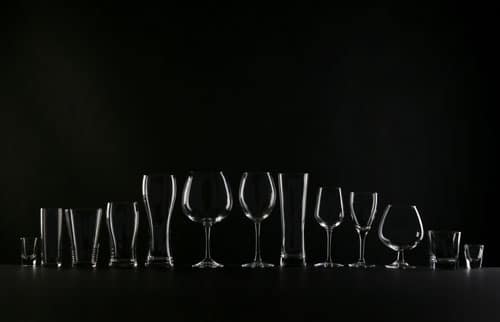Enameled glassware often contains toxic levels of the heavy metals lead and cadmium.
That’s the ominous finding of a new study by researchers from the University of Plymouth. They tested 72 drinking glass products, including tumblers, beer and wine glasses, and jars. More than 70% contained lead and cadmium.1
In some products with enameled rims, they found that lead concentrations were an astounding thousand-fold higher than the recommended limit. During experiments simulating sustained use, the study showed that enamel can flake off and be ingested.
Senior author Andrew Turner previously led a study showing toxic levels of heavy metals in children’s playground equipment. That research sparked headlines around the world. Dr. Turner believes the risks posed by drinking glasses could be even greater.2
“Hazardous elements in both the paint and glaze of decorated glassware has obvious implications for both human health and the environment,” Dr. Turner says. “So it was a real surprise to find such high levels of lead and cadmium, both on the outside of the glassware and around the rim.”
Lead Levels a Thousand Times Higher Than the Safe Limit
Long-term exposure to lead can cause brain damage, high blood pressure, heart disease, kidney problems, and infertility. Cadmium is linked to kidney, bone and lung disease.3 4
“There are genuine health risks posed through ingesting such levels of the substances over a prolonged period,” Dr. Turner said. “So this is clearly an issue that the international glassware industry needs to take action on as a matter of urgency.”
Dr. Turner and his colleagues identified lead in all colors of glass, including products decorated with gold leaf. They found that lead concentrations ranged from 40 to 400,000 parts per million (ppm).
The safe upper limit for lead in the externally decorated lip area of drinking glasses is 200 ppm, according to the U.S. Office of Environmental Health Hazard Assessment.
Cadmium concentrations ranged from 300 to 70,000 ppm. The highest levels were found in products with red enamel. The upper safe limit for cadmium in the externally decorated lip area of drinking glasses is 800 ppm.
The new study was published in the journal Science of the Total Environment.
How can you ensure that your glassware is safe?
For starters, choose non-colored, non-painted drinking glasses. Especially avoid those with enamel around the edge of the glass where you place your mouth.
And buy glassware made in the U.S. Those manufactured in Asia or Europe are more likely to contain heavy metals.
You’re not entirely safe even when using clear glassware that doesn’t have any enamel. That’s because it can be made out of lead crystal. This is high-end glassware, usually wine glasses or decanters. It contains at least 24% lead. Previous studies have shown that over time the lead in crystal can leach into the liquid it holds.5
You’re probably OK if you use crystal wine glasses occasionally. But use regular glass for everyday use. And don’t store wine or liquor in lead crystal decanters.6
Here’s a simple trick to tell the difference between lead crystal and plain glass…
Tap it gently with a knife. If it makes a drawn-out chiming sound, chances are it’s lead crystal. Regular glass makes a duller, briefer sound when struck.7
Like this Article? Forward this article here or Share on Facebook.
References:
1 https://www.eurekalert.org/pub_releases/2017-11/uop-dgc110117.php
2 https://medicalxpress.com/news/2016-01-playground-potential-danger-health.html
3 https://www.cdc.gov/niosh/topics/lead/health.html
4 https://www.osha.gov/SLTC/cadmium/healtheffects.html
5 https://www.webstaurantstore.com/article/260/is-lead-crystal-safe.html
6 http://www.nytimes.com/1991/02/20/garden/fda-issues-warnings-on-using-lead-crystal.html
7 https://www.michaelcfina.com/learn/how-to-tell-crystal-from-glass/

